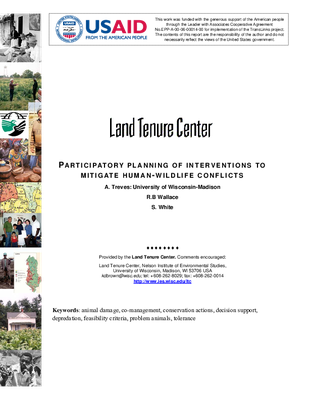Participatory Planning of Interventions to Mitigate Human-Wildlife Conflicts
ABSTRACT: Conservation of wildlife is especially challenging when the targeted species damage crops or livestock, attack humans, or take fish or game. Affected communities may retaliate and destroy wildlife or their habitats. We summarize recommendations from the literature for 13 distinct types of interventions to mitigate these human–wildlife conflicts. We classified eight types as direct (reducing the severity or frequency of encounters with wildlife) and five as indirect (raising human tolerance for encounters with wildlife) interventions. We analyzed general cause-and-effect relationships underlying human–wildlife conflicts to clarify the focal point of intervention for each type. To organize the recommendations on interventions we used three standard criteria for feasibility: cost-effective design, wildlife specificity and selectivity, and sociopolitical acceptability. The literature review and the feasibility criteria were integrated as decision support tools in three multi-stakeholder workshops. The workshops validated and refined our criteria and helped the participants select interventions. Our approach to planning interventions is systematic, uses standard criteria, and optimizes the participation of experts, policy makers, and affected communities. We argue that conservation action generally will be more effective if the relative merits of alternative interventions are evaluated in an explicit, systematic, and participatory manner.
https://biodiversitylinks.org/projects/completed-projects/translinks/translinks-2010/land-tenure-center/Report_ParticipatoryPlanningofHWCInterventions.pdf/view
https://biodiversitylinks.org/projects/completed-projects/translinks/translinks-2010/land-tenure-center/Report_ParticipatoryPlanningofHWCInterventions.pdf/@@download/image/image.png
File
Participatory Planning of Interventions to Mitigate Human-Wildlife Conflicts
Author(s):
Treves, A.,
Wallace, R.B.,
White, S.
Publication Date: 2010
DOWNLOAD FILE
ABSTRACT: Conservation of wildlife is especially challenging when the targeted species damage crops or livestock, attack humans, or take fish or game. Affected communities may retaliate and destroy wildlife or their habitats. We summarize recommendations from the literature for 13 distinct types of interventions to mitigate these human–wildlife conflicts. We classified eight types as direct (reducing the severity or frequency of encounters with wildlife) and five as indirect (raising human tolerance for encounters with wildlife) interventions. We analyzed general cause-and-effect relationships underlying human–wildlife conflicts to clarify the focal point of intervention for each type. To organize the recommendations on interventions we used three standard criteria for feasibility: cost-effective design, wildlife specificity and selectivity, and sociopolitical acceptability. The literature review and the feasibility criteria were integrated as decision support tools in three multi-stakeholder workshops. The workshops validated and refined our criteria and helped the participants select interventions. Our approach to planning interventions is systematic, uses standard criteria, and optimizes the participation of experts, policy makers, and affected communities. We argue that conservation action generally will be more effective if the relative merits of alternative interventions are evaluated in an explicit, systematic, and participatory manner.



